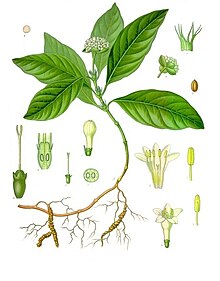Carapichea ipecacuanha
This scientific article needs additional citations to secondary or tertiary sources. (February 2017) |
| Carapichea ipecacuanha | |
|---|---|

| |
| Scientific classification | |
| Kingdom: | Plantae |
| Clade: | Tracheophytes |
| Clade: | Angiosperms |
| Clade: | Eudicots |
| Clade: | Asterids |
| Order: | Gentianales |
| Family: | Rubiaceae |
| Genus: | Carapichea |
| Species: | C. ipecacuanha
|
| Binomial name | |
| Carapichea ipecacuanha (Brot.) L.Andersson
| |
| Synonyms | |
|
Callicocca ipecacuanha | |

Carapichea ipecacuanha is a species of flowering plant in the family Rubiaceae. It is native to Costa Rica, Nicaragua, Panama, Colombia, and Brazil. Its common name, ipecacuanha (Portuguese pronunciation: [ipekɐkuˈɐ̃ɲɐ]), is derived from the Tupi ypekakûãîa (lit. 'duck penis').[1][better source needed] The plant has been discussed under a variety of synonyms over the years by various botanists. The roots were used to make syrup of ipecac, a powerful emetic, a longtime over-the-counter medicine no longer approved for medical use in the West for lack of evidence of safety and efficacy. An example of emetic compound from the roots is emetine.[2]
Description
[edit]Ipecacuanha is a slow-growing plant, which reduces its commercial appeal as a crop plant.[citation needed] It is seldom cultivated in South America but it has been cultivated in India and elsewhere.[3]
The root of ipecacuanha has been used in preparation of the medicament, the syrup, is simple or divided into a few branches, flexuous, and composed of rings of various size.[citation needed] It is somewhat fleshy when fresh, and appearing as if closely strung on a central woody cord.[citation needed] The different kinds known in commerce (gray, red, brown) are all produced by the same plant, the differences arising from the age of the plant, the mode of drying, etc.[citation needed] Various other plants can be used as substitutes for it.[clarification needed][citation needed]
History
[edit]Ipecacuanha was known to Europe by the mid 17th century. Nicholas Culpeper, an English botanist, herbalist, and physician, compared Ipecacuanha to the herb Orach in his book, Complete Herbal & English Physician, published in 1653.[full citation needed] One of the first recorded shipments of Ipecacuanha to Europe was in 1672, by a traveler named Legros, who imported a quantity of the root to Paris from South America.[4] In 1680, a Parisian merchant named Garnier possessed some 68 kilograms (150 pounds) of the substance and informed the physician Jean Claude Adrien Helvetius (1685–1755, father of Claude-Adrien Helvétius) of its power in the treatment of dysentery.[citation needed] Helvetius was granted sole right to vend the remedy by Louis XIV, but sold the secret to the French government, who made the formula public in 1688.[4]
Ipecacuanha has a long history of use as an emetic, for emptying the stomach in cases of poisoning, a use that has been discontinued in medical settings (see syrup of ipecac). It has also been used as a nauseant, expectorant, and diaphoretic, and was prescribed for conditions such as bronchitis. The most common and familiar preparation is syrup of ipecac, which was commonly recommended as an emergency treatment for accidental poisoning until the final years of the 20th century.[5] Ipecacuanha was also traditionally used to induce sweating. A common preparation for this purpose was Dover's powder.
In the 19th century, women prisoners at the Cascades Female Factory, Tasmania, were routinely given "a grain or so of ipecacuanha" as a precaution, especially "upon ladies with gross health and fiery temperaments."[6]
Chemical constituents
[edit]Ipecacuanha contains the alkaloids emetine (methylcephaeline) and cephaeline.[7] It also contains the pseudo-tannin ipecacuanhic acid or cephaëlic acid.[8][better source needed]
References
[edit]- ^ Ferreira, A. B. H. (1986). Novo dicionário da língua portuguesa (2nd ed.). Rio de Janeiro: Nova Fronteira. p. 966.
...pênis de pato...
- ^ Emmanuel S. Akinboye, Oladapo Bakare; Biological Activities of Emetine, The Open Natural Products Journal, 2011, 4, pp. 8-15; doi:10.2174/1874848101104010008
- ^ Wapf, Victoria (2018-01-30). The Disease of Chopin. A comprehensive study of a lifelong suffering. ISBN 9785040211166.
- ^ a b Druett, Joan (2001). Rough Medicine: Surgeons at Sea in the Age of Sail. pp. 61–62. ISBN 9780415924528.
- ^ American Academy Of Pediatrics Committee On Injury, Violence (November 2003). "Policy statement: Poison treatment in the home". Pediatrics. 112 (5): 1182–1185. doi:10.1542/peds.112.5.1182. PMID 14595067.
- ^ Daniels, Kay. Convict Women. Allen & Unwin, 1998, p. 129.
- ^ Roberts, Margaret F.; Wink, Michael (1998). Alkaloids: biochemistry, ecology, and medicinal applications / edited by Margaret F. Roberts and Michael Wink. ISBN 0306454653.
- ^ "530. Ipecacuanha.—Ipecac. | Henriette's Herbal Homepage".
External links
[edit]- R05CA04 (WHO) therapeutic classification
- . Encyclopædia Britannica (11th ed.). 1911.
- . New International Encyclopedia. 1905.
